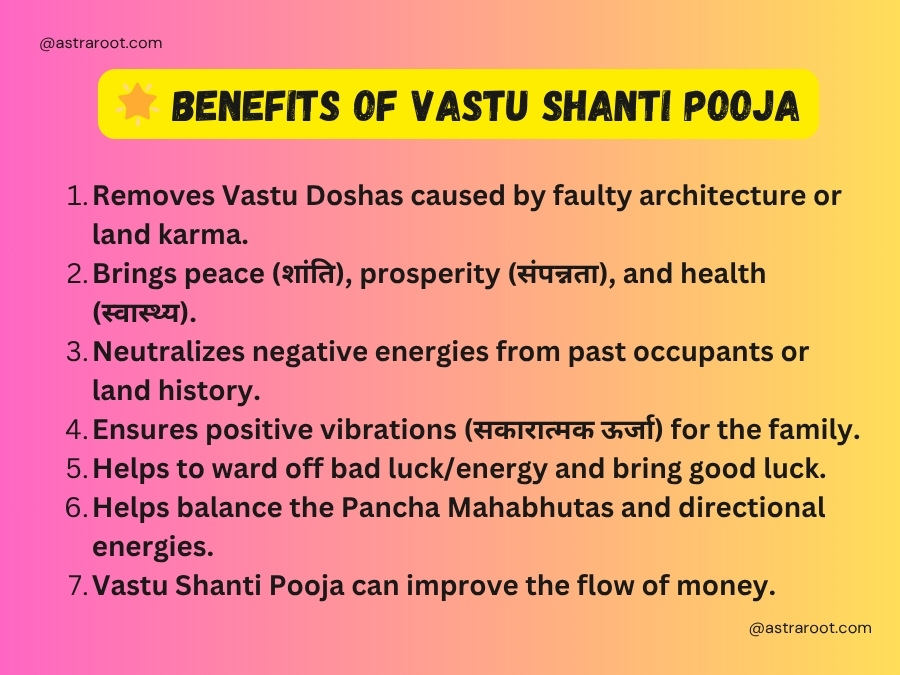Vastu Shanti Pooja – Meaning, Vidhi, Mantras & Benefits
Vastu Shanti (वास्तु शांति) is an essential Vedic Vastu Shastra ritual performed to balance the energies of a home or building and remove negative influences or Vastu doshas (वास्तु दोष).
Rooted in ancient Hindu scriptures, this ceremony aims to restore peace, prosperity, and spiritual harmony within the living space.
Let’s explore the meaning, process, benefits, mantras, and best time (muhurat) to perform Vastu Shanti Pooja, especially before housewarming or entering a new office, factory or property.
🕉️ What is Vastu Shanti?
Vastu Shanti is a sacred Hindu ritual/puja dedicated to pacifying the presiding deity of the house—Vastu Purush (वास्तु पुरुष).
According to Vastu Shastra, any disturbance or construction defect can offend Vastu Purush, leading to imbalance and disharmony. This pooja seeks forgiveness and blessings from the deity, ensuring a flow of positive cosmic energy (सकारात्मक ऊर्जा).
Why Perform Vastu Shanti? (वास्तु शांति क्यों करें?)
Vastu Shanti Pooja is performed to balance the energies of your home and remove any Vastu-related defects (वास्तु दोष).
It helps invite peace, prosperity, and positive vibrations by pacifying the Vastu Purush and aligning your space with nature’s five elements.
- During Griha Pravesh (गृह प्रवेश) or housewarming.
- Correct Vastu Doshas due to architectural flaws.
- After renovation or reconstruction.
- To remove Vastu Dosh (वास्तु दोष) and its effects.
- Attract wealth (धन), health, and family harmony.
- Balance Pancha Mahabhutas to ensure flow of “शुभ ऊर्जा”
- If a house is built on a disputed or previously negative site.
- Avert malefic effects of planets with Navagraha Shanti during the pooja.
📜 Significance of Vastu Purush in Vastu Shastra
In Vastu Shastra, Vastu Purush is the divine spirit residing in every building. The Vastu Purush Mandala (वास्तु पुरुष मंडल) is a cosmic grid used to design spaces in alignment with nature’s elements: Earth, Water, Fire, Air, and Space.
When any direction is blocked or wrongly used, the energy flow disrupts. Vastu Shanti Pooja helps align the building with these five elements (पंचतत्त्व) and divine forces.
वास्तु शांति मंत्र (Vastu Shanti Mantra):
- “ओम वास्तोष्पते प्रति जानीहि अस्मान स्वावेशो अनमीवो भवा नः। यत्वे महे प्रति तन्नो जुषस्व शन्नो भव द्विपदे शं चतुष्पदे स्वाहा”
- वास्तु शांति मंत्र अर्थ: हे वास्तुदेव, हमारे घर को अपना घर समझकर, हमें स्वस्थ और सुखी बनाएं। हमें सुख-समृद्धि प्रदान करें और हमारे दो पैरों और चार पैरों वाले सभी प्राणियों को शांति प्रदान करें।
- Om Vaastoshpate Prati Jaanidyasmaan Swaawesho Anamee Vo Bhavaan Yatve Mahe Pratitanno Jushasva Sahnno Bhav Dvipade Sham Chatushpade Swaahaa
- Vastu Shanti Mantra Meaning: O Vastu Lord! We worship you from our heart. Listen to our prayers and free us from disease and poverty. Also, fulfill our desire for wealth. Auspicious for all family members, animals and Vahnadi living in Vastu area or house.
🔱 Vastu Shanti Pooja Vidhi (वास्तु शांति पूजा विधि)
Here’s the general procedure for conducting a proper Vastu Shanti ceremony:
1. Purification of the House
- Clean the house and sprinkle Gangajal (गंगाजल) in every corner.
- Light incense sticks, camphor (कपूर), and dhoop.
2. Kalash Sthapana (कलश स्थापना)
- Set up a Kalash with water, mango leaves, coconut, rice, and turmeric.
- Chant Sankalp (संकल्प) with name, gotra, date, and location.
3. Vastu Mandala Puja (वास्तु मंडल पूजा)
- Offer flowers, sandalwood paste, and akshat (unbroken rice) to Vastu Purush.
- Perform Navagraha Shanti (नवग्रह शांति) for planetary harmony.
4. Havan (हवन / होम)
- Chant Vastu Shanti Mantras while offering ghee and herbs to the fire.
- Most important mantra: “Om Vastu Purushaya Namah”
5. Pradakshina & Aarti
- Circumambulate the fire or Kalash.
- Perform final Aarti and distribute Prasad.
✅ Note: A qualified Pandit (पंडित) should conduct this ceremony using authentic Vastu Shanti Samagri.
🌟 Benefits of Vastu Shanti Pooja
The benefits of performing Vastu Shanti Pooja are profound. It can transform your space into a sanctuary of positive energy, balance, and divine protection.
- Removes Vastu Doshas caused by faulty architecture or land karma.
- Brings peace (शांति), prosperity (संपन्नता), and health (स्वास्थ्य).
- Neutralizes negative energies from past occupants or land history.
- Ensures positive vibrations (सकारात्मक ऊर्जा) for the family.
- Helps to ward off bad luck/energy and bring good luck.
- Helps balance the Pancha Mahabhutas and directional energies.
- Vastu Shanti Pooja can improve the flow of money.

🗓️ Best Time (Muhurat) for Vastu Shanti
Ideal muhurats for performing Vastu Shanti Pooja include:
- Akshaya Tritiya (अक्षय तृतीया)
- Navratri (नवरात्रि)
- Diwali / Dhanteras (धनतेरस)
- Gudi Padwa / Ugadi
- During auspicious Nakshatras like Rohini, Hasta, Pushya, or Ashwini.
✅ Note: Consult your family priest or astrologer for a personalized Shubh Muhurat (शुभ मुहूर्त) based on your Janm Kundli (जन्म कुंडली).
🕯️ Vastu Shanti Mantras (वास्तु शांति मंत्र)
Here are a few powerful mantras used during the pooja:
ॐ वास्तोष्पते प्रतिजानिते गनमस्मिन्स्वाहा
Om Vastu-pate pratijanite ganamasmin swaha
ॐ वास्तुपुरुषाय नमः
Om Vastu Purushaya Namah
ॐ नमो भगवते वासुदेवाय
Om Namo Bhagavate Vasudevaya
🛕 Vastu Shanti Pooja Samagri List (वास्तु शांति पूजा में लगने वाली सामग्री)
A Vastu Shanti puja samagri list typically includes items for worshipping the Vastu Purusha, Lord Ganesha, and other deities, as well as materials for conducting a havan (fire ritual). Below is the complete list of items needed for performing the Vastu Shanti Pooja:
🔸 Basic Samagri
- कलश (Kalash – copper pot)
- नारियल (Coconut)
- आम के पत्ते (Mango leaves)
- गंगाजल (Ganga water)
- चावल (Akshat – unbroken rice)
- हल्दी (Turmeric powder)
- कुमकुम या रोली (Kumkum or Roli)
- फूल (Fresh flowers – marigold, rose, lotus)
- सुपारी (Betel nuts)
- पान के पत्ते (Betel leaves)
- फल (Fruits – banana, apple, orange)
- मिठाई (Sweets – preferably homemade or satvik)
- धूपबत्ती/अगरबत्ती (Incense sticks)
- कपूर (Camphor)
- घी (Desi ghee – for havan)
🔸 Pooja Accessories:
- पूजा थाली (Pooja thali or plate)
- जल पात्र (Water container or Lota)
- छोटी कटोरी (Small bowls for haldi, kumkum, etc.)
- दीया/घी का दीपक (Oil/ghee lamp)
- रूई की बाती (Cotton wicks)
- मौली या कलावा (Red sacred thread)
- पंचमेवा (Dry fruits: cashew, almond, raisins, etc.)
- धोती/साड़ी (For deity/kalash decoration or priest)
🔸 Havan Samagri:
- हवन कुंड (Havan Kund – fire pit)
- आम की लकड़ी या समिधा (Mango wood sticks or Samidha)
- हवन सामग्री (Herbal havan mix – available in packets)
- घी (for ahuti)
- जौ या तिल (Barley or sesame seeds)
- लौंग, इलायची (Clove, cardamom)
- घी में भिगा रुई (Ghee-soaked cotton for lighting)
🔸 Other Sacred Items:
- वास्तु पुरुष यंत्र या चित्र (Vastu Purush Yantra or printed mandala)
- नवग्रह यंत्र या चित्र (Navagraha Yantra or idols)
- लाल कपड़ा (Red cloth to cover Kalash or altar)
- माटी का कलश या दीपक (Earthen lamp or pot)
- तुलसी के पत्ते (Tulsi leaves – for spiritual purity)
- स्फटिक माला (Sphatik mala or crystal beads for mantra chanting)
- पंचगव्य (Panchagavya – cow milk, ghee, curd, cow dung, cow urine). पंचगव्य या पंचकाव्यम पारंपरिक हिंदू अनुष्ठानों में इस्तेमाल किया जाने वाला मिश्रण है जिसे पाँच सामग्रियों को मिलाकर तैयार किया जाता है। तीन प्रत्यक्ष घटक गाय का गोबर , गोमूत्र और दूध हैं; दो व्युत्पन्न उत्पाद दही और घी हैं।
🏡 Difference Between Vastu Shanti and Griha Pravesh
While both Vastu Shanti and Griha Pravesh are essential Hindu rituals performed when entering a new home, they serve different purposes and are often performed together, yet they are not the same.
| Aspect | Vastu Shanti (वास्तु शांति) | Griha Pravesh (गृह प्रवेश) |
| Meaning | A pooja to pacify Vastu Purush, remove Vastu doshas, and balance five elements | A ceremonial first entry into a new home with Vedic rituals |
| Purpose | To purify the land/home from past karma, architectural faults, and planetary imbalances | To seek blessings for peace, prosperity, and happiness in the new home |
| Focus | Correcting energy imbalance and pacifying directions (दिशाएं) | Celebrating a new beginning and welcoming deities into the home |
| Performed When | Before Griha Pravesh, after renovation, or on discovering Vastu dosh | On the first entry into a new or renovated home (must be auspicious muhurat) |
| Main Rituals Involved | Kalash Sthapana, Vastu Purush Mandala pooja, Navagraha Shanti, Havan | Ganapati Pooja, Lakshmi-Narayana Pooja, lighting the lamp, entering with Kalash |
| Importance | Ensures energetic and architectural alignment of the house with cosmic energies | Marks the start of new life in a house with divine blessings |
| Can Be Done Separately? | Yes – especially if house has Vastu dosh/faults | Usually performed with or after Vastu Shanti, not alone if faults exist |
📝 In Simple Terms:
- Vastu Shanti is like spiritually cleaning and aligning the house.
- Griha Pravesh is about entering and living in that house with blessings.
Both are interconnected but distinct, and together they ensure that your new home becomes a place of peace, prosperity, and positivity.
💬 FAQs on Vastu Shanti
Q1. Can Vastu Shanti be done without a Pandit?
A. It is best performed by a Vedic Pandit for accuracy and energetic impact.
Q2. Is Vastu Shanti necessary for rented houses?
A. Yes, especially if previous occupants had misfortune or if the house feels energetically heavy.
Q3. How much does Vastu Shanti Pooja cost?
A. ₹2500 to ₹21,000 depending on rituals, region, and number of priests.
Q4. Can I do Griha Pravesh without Vastu Shanti?
A. It is not advisable. Vastu Shanti ensures harmony before entering your new space.
Q5. Who can perform Vastu Shanti Pooja?
A. A Hindu priest knowledgeable in Vastu Shastra and Hindu rituals should perform the Pooja.
Q6. When is Vastu Shanti Pooja performed?
A. The Vastu Shanti Pooja is performed before moving into a new home or starting a new business, to ensure that the environment is positive and remove any vastu dosh/defects present in the property.
Vastu Shanti Invitation Card

🏠 Final Thoughts
Performing Vastu Shanti Pooja is a time-honored way to cleanse your home and align it with divine energies. Whether you’re moving into a new flat or building your dream home, this ceremony acts like a spiritual insurance—balancing karma, energy, and planetary influences.
Bring blessings, stability, and abundance into your home by respecting the spiritual science of Vastu Shastra.
Feel free to share your queries and feedback in the comments below, and spread the wisdom of Vastu Shastra on social media to inspire others!
Disclaimer: The insights shared in this article are based on my knowledge and understanding of Vastu Shastra. While these principles are meant to guide and inspire, it is recommended to consult a qualified Vastu expert for personalized advice tailored to your space and requirements.



